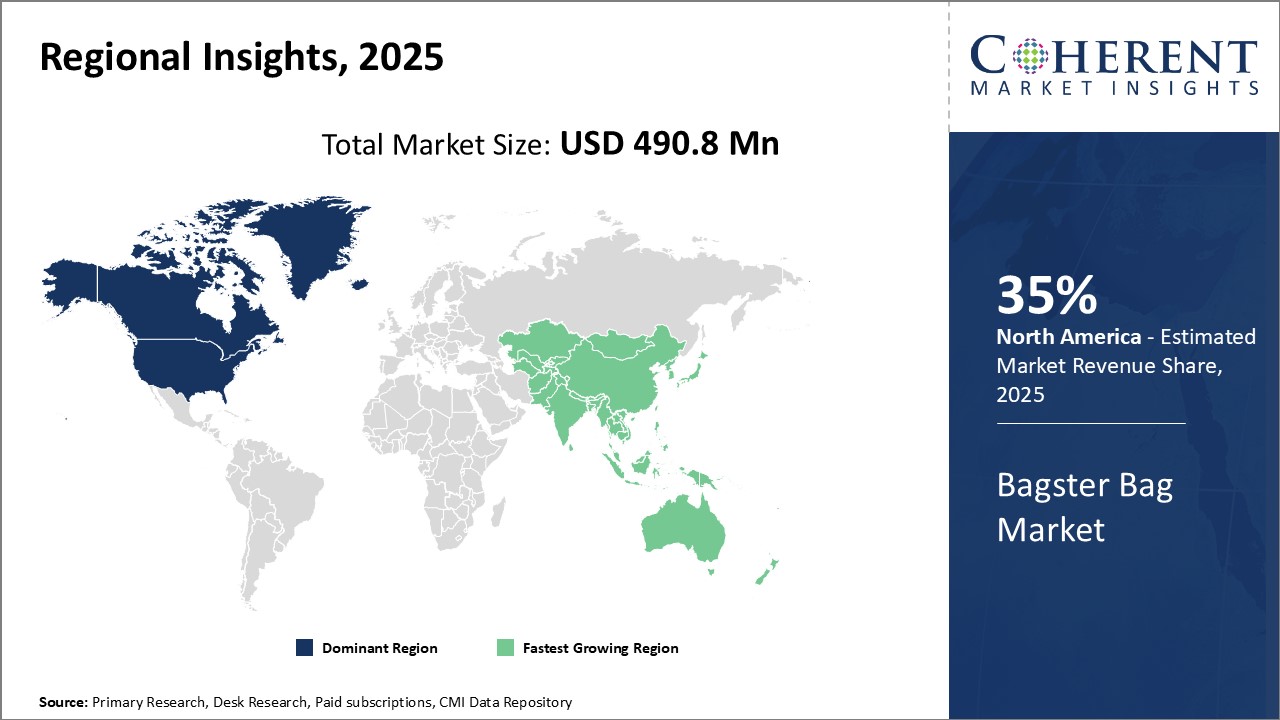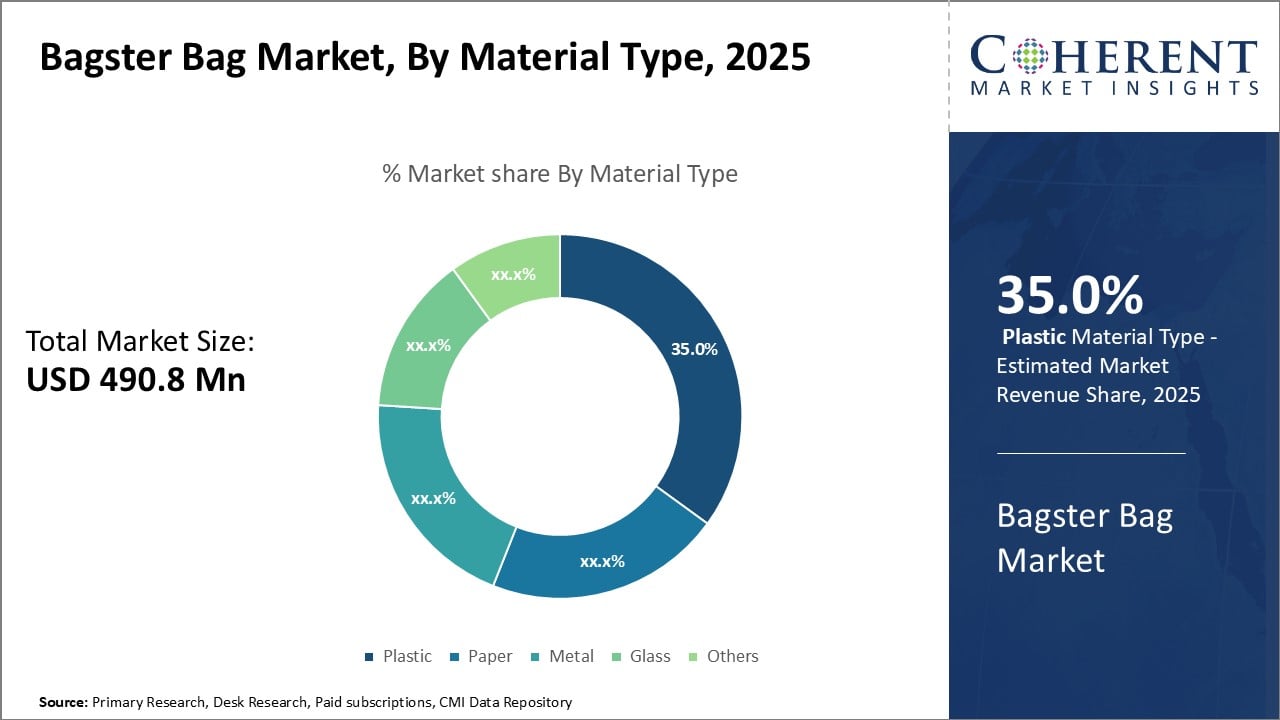Bagster bag market is expected to reach US$ 645.7 Mn by 2032, from US$ 490.8 Mn in 2025, exhibiting a CAGR of 3.7% during the forecast period.
Bagster bags are large, sturdy bags that are used for collecting waste and recyclable materials. These provide an easy and convenient way for households and businesses to dispose of trash and recycle treash without requiring a dumpster rental. Key advantages of bagster bags include easy loading, transportation, and unloading. The market growth is driven by growing environmental concerns, rising urbanization leading to greater waste generation, and supportive government regulations.
Bagster bag market is segmented by material type, by end user, distribution channel, product type, by region. Among material type, plastic segment dominates the market owing to the durability and versatility of plastic bags.
Bagster Bag Market Regional Insights:
- North America accounted for 35% of the bagster bag market share in 2025. The market growth in North America is attributed to high consumer awareness regarding waste management and recycling, along with strict government regulations.
- Europe accounted for 25% of the bagster bag market share in 2025. The market growth in Europe is attributed to growing adoption of sustainable waste management practices.
- Asia Pacific accounted for 18% of the bagster bag market share in 2025. The market growth in Asia Pacific is attributed to rapid urbanization and industrialization in emerging economies such as China and India.
Figure 1. Global Bagster Bag Market Share (%), by Region, 2025

To learn more about this report, Download Free Sample
Bagster Bag Market Drivers:
- Growing construction industry: Growing construction industry across the globe can drive the bagster bag market growth. With increasing construction of new residential and commercial buildings, the volume of construction waste and debris has increased substantially over the past few years. Bagster bags provide a convenient solution for contractors and construction companies to dispose large amounts of construction and demolition waste in an eco-friendly manner. According to data published by United Nations Economic Commission for Europe, construction output in North America had increased by 5.2% in 2020 as compared to the 2019 despite disruptions caused by the COVID-19 pandemic. Construction growth in developed Asian countries like China, South Korea and Japan was increased by 2-4% during the same period. This steady rise in construction activities is expected to continue in the near future due to robust investment in infrastructure projects, affordable housing schemes as well as commercial and industrial building construction. With increasing construction volumes, the number of debris to be disposed at sites will also increase. This will further boost demand for bagster bags and similar flexible containment solutions for waste management in the construction industry.
- Stringent Government Regulations: Governments across the world are implementing strict waste management regulations to tackle the problem of overflowing landfills, greenhouse gases emissions from organic waste, and plastic pollution. Several countries have mandated households and businesses to segregate their waste at source for recycling. There are also regulations restricting the use of single-use plastics and promoting the use of compostable bags. Such regulations boost adoption of bagster bags as convenient and affordable waste collection and segregation solutions.
Bagster Bag Market Opportunities:
- Biodegradable Materials: There is an emerging opportunity for eco-friendly and biodegradable materials such as plant starch blends and compostable biopolymers in the bagster bags market. With growing environmental awareness among consumers, manufacturers have the opportunity to develop 100% compostable bagster bags that can decompose without leaving behind toxic residue. Biodegradable bags made using natural fibers and plant-based resins can be used in applications involving yard trimmings, food waste, and agricultural refuse collection.
- Online Sales: Global expansion of e-commerce networks offers lucrative growth opportunities for manufacturers to sell bagster bags online, directly to end-use consumers. Online sales channels allow access to a wider consumer base. It also enables bundling bagster bags with complimentary products like smaller trash bags, ties, gloves, cleaning solutions, and others to provide an integrated waste management solution. Online sale channels provide user-friendly features such as customized capacity, subscription models, and doorstep delivery.
- Emerging Markets: Developing nations across Asia, Africa, and Latin America present untapped opportunities for bagster bag sales. Rapid urbanization in these countries can lead to a garbage crisis in the cities. Implementing local manufacturing and distribution infrastructure in emerging markets can help bagster bag companies tap into the growing waste collection needs of households and industries in these regions. Creating awareness about source waste segregation is essential to expand sales of these bags.
Bagster Bag Market Report Coverage
| Report Coverage | Details | ||
|---|---|---|---|
| Base Year: | 2024 | Market Size in 2025: | USD 490.8 Mn |
| Historical Data for: | 2020 To 2024 | Forecast Period: | 2025 To 2032 |
| Forecast Period 2025 to 2032 CAGR: | 3.7% | 2032 Value Projection: | USD 632.9 Mn |
| Geographies covered: |
|
||
| Segments covered: |
|
||
| Companies covered: |
Waste Management Inc., Republic Services Inc., Clean Harbors Inc., Covanta Holding Corporation, Stericycle Inc., Advanced Disposal Services, Casella Waste Systems, Recology, Biffa, REMONDIS SE & Co. KG |
||
| Growth Drivers: |
|
||
| Restraints & Challenges: |
|
||
Uncover macros and micros vetted on 75+ parameters: Get instant access to report
Bagster Bag Market Trends:
- Smart Waste Management: Integration of IoT technologies such as tracking sensors, Bluetooth connectivity, and big data analytics with bagster bags to enable intelligent waste monitoring is an emerging trend. Smart features allow remote fill-level monitoring, optimize waste collection routes, provide usage insights, and send proactive re-ordering alerts. These can help significantly improve operational efficiency, customer convenience, and sustainability.
- Omnichannel Retailing: Leading bagster bag retailers are adopting omnichannel strategies involving a combination of physical stores, e-commerce, mobile apps, social commerce, and digital advertising. Omnichannel facilitates seamless customer experience and provide retailers greater flexibility. Retailers are striving to deliver a unified brand experience across channels.
Bagster Bag Market Restraints:
- Competition from Alternative Products: The wide availability of substitute products such as traditional trash cans, dumpsters, crates, and woven sacks can put pricing pressures on bagster bag manufacturers. Consumers can opt for lower-priced alternatives or reuse free containers like cardboard boxes for waste handling. Unless bagster bags can demonstrate greater convenience and value for money, preference for cheap alternatives can hamper the market growth
- Fluctuating Raw Material Costs: Bagster bags production involves raw materials like polyethylene, polypropylene, biopolymers, and others derived from crude oil and gas. Pricing volatility in petrochemical feedstocks due to supply-demand dynamics, geopolitics, and exchange rate fluctuations can impact manufacturer profit margins. Rising materials costs can increase prices of bagster bag, thus, affecting affordability of these bags.
Recent Developments:
New product launches:
- In April 2022, Tesco, a U.K.-based multinational grocery and general merchandise retailer, partnered with Recycling Technologies to offer recycle bags in over 600 stores in the U.K. The bags allow consumers to recycle flexible plastic from their homes.
- In January 2021, Amazon, an American multinational technology company that focuses on e-commerce, cloud computing, digital streaming, and artificial intelligence, launched it recycle bag to enable easy recycling for customers in the U.K. The large bagster bags allow customers to collect recyclables before dropping them off at recycling centers.
- In September 2020, Coles, a Australia-based supermarket chain, made significant strides in its sustainability efforts and commitment to reducing plastic waste by launching various initiatives related to reusable and sustainable bags like launch of new reusable bags and plastic bags made from marine waste. Coles launched reusable bagster bags as part of its goal to reduce plastic waste. The sturdy bags can be used up to 100 times.
Acquisition and partnerships:
- In January 2022, Republic Services, a waste management company, acquired U.S. Ecology, a leading environmental solutions company. Republic Services acquired U.S. Ecology to expand its environmental solutions capabilities, including waste disposal and recycling services.
- Waste Management is a leading provider of comprehensive waste management and recycling services. The company offers a wide range of services, including garbage collection, recycling pickup, dumpster rental, and environmental stewardship. In April 2021, Waste Management partnered with OPTI Resource Management Group to offer recycling and waste management services in Canada. Resource Management Group (RMG) is a nationally recognized boutique search practice specializing in executive-level finance positions.
- Covanta is a leader in sustainable materials management, providing environmental solutions to businesses and communities as a private energy-from-waste and industrial waste management services company headquartered in U.S. In December 2020, Covanta acquired GERs ID’s waste and recycling operations to expand its waste management infrastructure in the Northeast U.S.
Figure 2. Bagster Bag Market Share (%), By Material Type, 2025

To learn more about this report, Download Free Sample
Top companies in Bagster Bag Market:
- Waste Management Inc.
- Republic Services Inc.
- Clean Harbors Inc.
- Covanta Holding Corporation
- Stericycle Inc.
- Advanced Disposal Services
- Casella Waste Systems
- Recology
- Biffa
- REMONDIS SE & Co. KG
*Definition: Bagster bag refers to the global market for large, sturdy bags designed for the collection and transportation of trash, garbage, recyclables, yard waste, and other materials. Key product types in this market include garbage bags, trash bags, recycling bags, and compostable bags. Bagster bags provide a convenient and affordable solution for the waste management needs of households, businesses, construction sites, institutions, and even cities. The growing volumes of waste generation and rising awareness about sustainability are expected to drive the growth of the Bagster bag Market.
Few Other Promising Reports in Packaging Industry
Share
Share
About Author
Shivam Bhutani has 6 years of experience in market research and strategy consulting. He is a Market Research Consultant with strong analytical background. He is currently an MBA candidate specializing in Business Analytics from BITS Pilani.
He is adept at navigating diverse roles from sales and marketing to research and strategy consulting. He excels in market estimation, competitive intelligence, pricing strategy, and primary research. He is skilled at analysing large datasets to provide precise insights, helping clients in achieving strategic transformation across various industries. He is skilled in leveraging data visualization techniques to drive innovation and enhance business processes.
Missing comfort of reading report in your local language? Find your preferred language :
Transform your Strategy with Exclusive Trending Reports :
Frequently Asked Questions
Select a License Type
EXISTING CLIENTELE
Joining thousands of companies around the world committed to making the Excellent Business Solutions.
View All Our Clients




